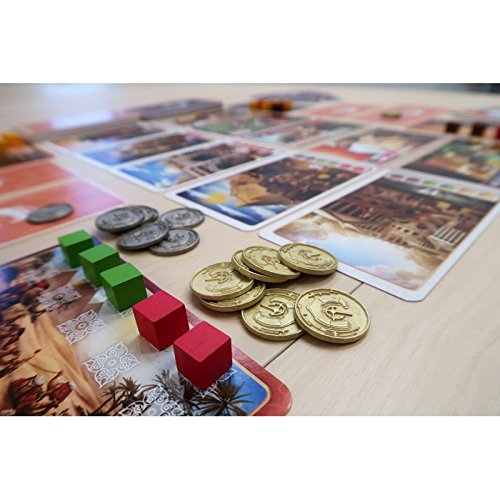Building Your Own Spice Trade Route with Century: Spice Road
Outside out of a game like Machi Koro, I haven’t had the chance to explore many games that focus specifically on deck building. But on a recent trip to try out some new board games, this one caught my eye. As someone who has always loved playing computer games that focused on trading during the golden age of piracy, I thought I’d give it a shot.
Century: Spice Road is the first in a series of games that explores the history of each century. Part of a trilogy, it integrates with both Century: A New World and Century: Eastern Wonders.
Built for 2-5 players, the optimum time for gameplay is around 30-45 minutes. Each player is a caravan leader that is traveling the Silk Road to trade spices and earn the highest number of victory points. The game has 4 spices (in the form of colored cubes), from least to most valuable: turmeric (yellow), saffron (red), cardamom (green) and cinnamon (brown). Players have a caravan card, which can hold up to ten spice cubes and two cards – the first one lets you start off with two yellow cubes from the supply and the second one lets you upgrade two of your cubes to better spice cubes from the supply. Market cards and scoring cards are also laid out in two rows.
The row of market cards that contain different actions on them. Some of them will allow players to take more turmeric cubes from the supply, others will require players trade in a certain amount of spices to upgrade (ie. trading in 4 cardamom cubes for one cinnamon cube) and some will also let players exchange certain spices for others (ie. one saffron cube for three turmeric cubes). There are also scoring cards with numbers on them that you can claim, depending on the number of spice cubes on each card and the cubes in your caravan.
During each player’s turn, you’re allowed to play a card from your own hand and claim the benefits (ie. upgrading or exchanging spices), take a new card from market row, put all of the previously played cards back into their card or claim a scoring card. However, there is a caveat. The market row will always contain 6 cards but only the card at the left end of the row is free. For all the other ones, you must spend a spice cube to skip to the one you want.
As I mentioned before, you claim a scoring card by spending a certain amount of spices. In the row of scoring cards, you’ll always have five. But you’ll only claim one of the 3 point gold coins or one point silver coins if that particular scoring card was in the first two columns (with the market cards lined up in a row above the scoring card row).
So how do you win? Each round ends when a player takes a 5thscoring card. The values of every players’ scoring cards are tallied up along with any bonus coins. Players also receive points for every non-yellow cube they have at the end of each round.
Playing this game is really about strategy. I had to be really careful about which cubes I chose to give up in order to upgrade or exchange them, knowing that it could negatively impact my chances at getting a scoring card. When you’re focusing on upgrading and/or exchanging, it can also be hard to not end up with an empty caravan. At least twice, I was faced with an empty caravan because I wanted to take the risk of exchanging more cubes for less (ie. trading in 5 cardamom cubes for 2 cinnamon) for an opportunity at a scoring card. While doing that doesn’t end the game right away, it did force me to take more time just to replenish the caravan again.
I would definitely recommend this game for people who enjoy strategy and deck building but don’t want to spend a lot of time on it. Having around 30-45 mins allows the forward progression in the game to move much quicker and it definitely keeps you on your toes. Definitely pick it up through your local board game store or on Amazon.
Looking for a game for game night? Check out more board game reviews here!
by Lillian Sue





